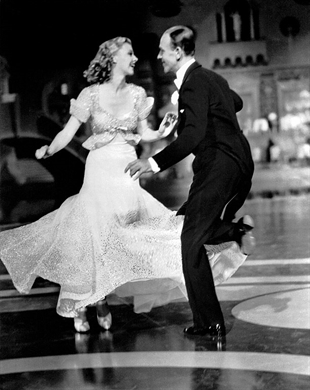
(DON THOMPSON / iNFOnews.ca)
March 11, 2024 - 12:00 PM
OPINION
Have you ever thought about being another person? No, not because you’re disappointed in your own life, merely a fantasy, an “I-wish-I-could-be-like-that” sort of thing.
For me, if I could have lived anyone else’s life…it would be Frederick Emanuel Austerlitz. Oh, sorry, Fred Astaire. Most of us know Astaire for his second-to-none movements on the dance floor. He made what he did look easy…graceful, elegant…perfect.
Most people underestimated Astaire’s talents, skills, looks, voice - just about everything about him - well into his 30s. Maybe that’s what I like most about him…he was great at proving people - so-called experts - wrong.
In 1932, an RKO Radio Pictures talent scout penned this opinion about Astaire’s first screen test: “Can’t act; slightly bald; can dance a little.” Hmmm…the studio executive probably regretted the comment his entire career.
What Fred Astaire possessed was an undefinable charm that countered any shortcomings…like big ears or his lack of rugged movie star good looks. He was - above all - likeable...which came through in person or on film. And, of course, he could dance more than a little.
When you see Astaire in any one of the 36 movies he made…you think the man is at least tall, if not dark and handsome. He was 5-foot, 9-inches. He seemed taller because, of course, he was thin…with a 31-inch waist…a few inches bigger than my thigh.
Also, rarely did he dance with a partner who was tall…Ginger Rogers at 5-foot, 4-inches…Leslie Caron at 5-foot, 1-inch, Cyd Charisse and Rita Hayworth, both at 5-foot, 6-inches, and Eleanor Powell, just 5-foot, 5-inches, and Judy Garland, just shy of 5 feet tall.

Ginger Rogers and Fred Astaire
Image Credit: WIKIMEDIA COMMONS/RKO Radio Pictures
When it came to clothing and style, Astaire could look aristocratic when the need called for it, but ironically he’s often thought of in top hat and tails when he was primarily responsible for popularizing the sports jacket and soft, well-draped trousers with a slight break at the shoes.
His attitude - stemming from self-confidence no doubt - allowed Astaire to wear white ties and tails as though they were pyjamas. He never looked uncomfortably formal like the father of the bride…in a tuxedo he simply look natural. That’s what has always guided my own style…formal or casual.
Astaire’s second movie, “Flying Down to Rio” was actually a vehicle for actress Dolores del Rio, but the two supporting actors - Astaire and Ginger Rogers - stole the show. They were both relatively unknown in 1933, but after lighting up the screen in a dance called "The Carioca"…the two would go on to make nine movies as bonafide stars.
One of the reasons I love old movies are things you could get away with as a director, writer and producer. Ginger Rogers, standing outside a bakery in Rio, asks Astaire’s character (also a Fred), "Oh, Freddie, how do you ask for little tarts in Portuguese?"
Astaire’s retort, "Don't heckle me, try the Culbertson System." This was a double entendre that brought laughs to Depression-era audiences because bridge was a common pastime and Ely Culbertson was a champion bridge player and worldwide playboy. Tart - by the way - was the era’s expression for a whore or prostitute.
If you ever watch the movie, check out the see-through blouses of the chorus girls on the wings of a plane…The Hays Code ended all that two years later…enforcing “morality” until 1968.
Astaire was a dancer from early on. As a toddler, Fred would go with his mother to pick up his sister Adele from her ballet lessons in Omaha, NB. After a few trips, Fred - a bored child not yet three - slipped on ballet slippers tossed aside and proceeded to walk on his toes…as he saw his sister and the others do.
By the time he was six, he and sister, Adele, were performing in vaudeville in New York City. They were dancing partners for a dozen years, until she married an English nobleman, Lord Charles Arthur Francis Cavendish.
Many thought Adele was the best dancer…with even a Chicago newspaper critic remarking about Fred - now a single hoofer - said, “Two Astaires are better than one.” Astaire didn’t let that bother him too much.
Despite a general air of confidence, Astaire had doubts about films, even though it would give him an opportunity to dance in front of millions of people. He lacked the chiseled good looks of Cary Grant, Gary Cooper, Gregory Peck or Clark Gable. Also, he feared his footwork would be a blur on film.
Further, his voice lacked the strength and range of a Frank Sinatra or Bing Crosby. Any yet, by the late 1950s it would be Fred Astaire who popularized more songs in musical cinema than any other singer.
His innovative choreography and introducing concepts like shooting a complete dance number with a single fixed camera made him seem less like a carnival-tent act in large studios and bolstered his confidence. Before Astaire, dance sequences amounted to fast cuts and close-ups…rather than full-length, start-to-finish shots.
It was as David O. Selznick said about that first screen test…“I am a little uncertain about the man, but I feel, in spite of his enormous ears and bad chin line, that his charm is so tremendous that it comes through even in this wretched test…”
In some ways Astaire’s career was kismet…his closest friend growing up in New York City as a teenager was George Gershwin. When Astaire was 15 and Gershwin 16, they dreamed and talked of Gershwin writing a Broadway musical just for Astaire.
Their dreams came true, time and time again, with Broadway shows like “Funny Face” in 1927, and movies like “Shall We Dance” in 1937, the first film George and Ira Gershwin scored.
I’ve seen every Fred Astaire movie…three dozen…most of them multiple times. I like everything about each one…his acting, his singing, and, of course, his dancing. “The Gay Divorcee”, “Top Hat”, “Swing Time”, “Holiday Inn”, “Silk Stockings”, “The Barkleys of Broadway”…I’ll never stop watching them.
My wife, Bonnie, and I - like many couples - have “our song”…Cole Porter’s “Night and Day”. It has been covered by so many great singers…Tony Bennett, Frank Sinatra, Ella Fitzgerald, Bing Crosby, Mel Torme…and scores of others.
But when you hear Fred Astaire…who first recorded it…it simply sounds more authentic. Sinatra never sang it in concert, saying, “You’d be a fool to try and better Astaire.”
We can’t be someone else, of course, but if I could…I’d be quite comfortable in Fred Astaire’s skin. Besides, I’m certain another critic might well say of me, “Can’t act; slightly bald; can dance a little.”
— Don Thompson, an American awaiting Canadian citizenship, lives in Vernon and in Florida. In a career that spans more than 40 years, Don has been a working journalist, a speechwriter and the CEO of an advertising and public relations firm. A passionate and compassionate man, he loves the written word as much as fine dinners with great wines.
We welcome your comments and opinions on our stories but play nice. We won't censor or delete comments unless they contain off-topic statements or links, unnecessary vulgarity, false facts, spam or obviously fake profiles. If you have any concerns about what you see in comments, email the editor.
News from © iNFOnews, 2024